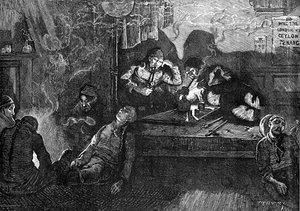Opium
|
|
Opium is a narcotic drug which is obtained from the unripe seed pods of the opium poppy (Papaver somniferum L. or the synonym paeoniflorum).
| Contents |
Harvesting opium
To harvest opium, the skin of the ripening pods is scored by a sharp blade. The slashes exude a white, milky latex, which dries to a sticky brown resin that is scraped off the pods as raw opium.
Opium has powerful narcotic properties, and is used as a painkiller in extreme circumstances, such as in terminal stages of cancer. Therefore, a small amount of legal production is discreetly conducted under strict supervision from law enforcement. The leading legal producers of opium are France and Australia. The French company Francopia produces 20% to 25% of the world's total, with total sales of approximately 60 million €.
Opium preparation
Raw opium must be processed and refined (called "cooking") before it is suitable for smoking. The raw opium is first dissolved in water and simmered over a low heat. Mild acidification of the solution can aid in extraction of the alkaloids. The brown solution is then filtered to remove the insoluble vegetable waxes and then evaporated over a low heat. The result is a smokable form of opium with a considerably higher morphine content percentage-wise than the raw latex. This is then pressed into bricks and either transported to heroin laboratories or used as is.
Although opium is used in the form of paregoric to treat diarrhea, most opium imported into the United States is broken down into its alkaloid constituents. These alkaloids are divided into two distinct chemical classes, phenanthrenes and isoquinolines. The principal phenanthrenes are morphine, codeine, and thebaine, while the isoquinolines have no significant central nervous system effects and are not regulated under the Controlled Substances Act. Opium is also processed into heroin, and most current drug abuse occurs with processed derivatives rather than with raw opium.
The seed capsules also contain morphine, codeine, and other alkaloids. These pods can be boiled in water to produce a bitter tea that induces a long-lasting intoxication. Addiction to poppy tea is rare, but does occur.
Chemical properties and physiological effects
Opium resin contains two groups of alkaloids: phenanthrenes (including morphine and codeine) and benzylisoquinolines (including papaverine). Morphine is by far the most prevalent and important alkaloid in opium, consisting of 10%-16% of the total. It binds to and activates μ-opioid receptors in the brain, spinal cord, stomach and intestine. Regular use, even for a few days, invariably leads to physical tolerance and dependence. Various degrees of psychological addiction can occur, though this is relatively rare when opioids are properly used to treat pain as opposed for their euphoric effects. Strong pain is so stimulating itself that dependence when treating strong pain is rare. These mechanisms result from changes in nervous system receptors in response to the drug. In response to the drug, the brain creates new receptors for opiates. These receptors are "pseudo" receptors and do not work. When the opiates are out of the body, the brain has more receptors than before the use of the drug, but only the same amount of endogenus opiates (endorphins) to fill these receptors.
History of opium
The image of the poppy capsule was an attribute of deities, long before opium was extracted from its milky latex. At the Metropolitan Museum's Assyrian relief gallery, a winged deity in a bas-relief from the palace of Ashurnasirpal II at Nimrud, dedicated in 879 BC, bears a bouquet of poppy capsules, described by the museum as pomegranates.
Opium has been a major item of trade for centuries, and has long been used as a painkiller and sedative. It was well known to the ancient Greeks, who named it opion ("poppy juice"), from which the present name - a Latinisation - is derived. Many patent medicines of the 19th century were based around laudanum (known as "tincture of opium", a solution of opium in Ethyl alcohol). Opium can also be smoked, sometimes in combination with tobacco. Opium smoking was often associated with immigrant Chinese communities around the world, with "opium dens" becoming notorious fixtures of many Chinatowns.
In the 19th century, the smuggling of opium to China from India, particularly by the British, was the cause of the Opium Wars. It led to Britain seizing Hong Kong and to what the Chinese term the "century of shame". This illegal trade became one of the world's most valuable single commodity trades and was described by the eminent Harvard University historian John K. Fairbank as "the most long continued and systematic international crime of modern times."
There were no legal restrictions on the importation or use of opium in the United States until the Harrison Narcotics Tax Act of 1914. Medicines often contained opium without any warning label. Today, there are numerous national and international laws governing the production and distribution of narcotic substances. Its pharmaceutical use is strictly controlled worldwide and non-pharmaceutical uses are generally prohibited.
See also
Opium is also known as afeem.
- Sir Thomas Browne
- China trade
- Samuel Taylor Coleridge
- Forbes family
- John Keats
- opioid
- Opium Wars
- Thomas de Quincey
- Symphonie Fantastique
- Malwa
External links
- Erowid Opium Vault (http://www.erowid.org/chemicals/opiates/opiates.shtml)
- A New Opium War (http://montages.blogspot.com/2004/12/new-opium-war.html)
- Geopium: Geopolitics of Illicit Drugs in Asia (http://www.geopium.org)
- Opium in Japan (http://www.taima.org/en/opium.htm)
- Hall of Opium (http://www.goldentrianglepark.org/)
- Opium Poppies (http://www.poppies.org)
- From Flowers to Heroin (http://www.cia.gov/cia/publications/heroin/flowers_to_heroin.htm), CIA publication
- Opium Made Easy (http://www.wesjones.com/pollan1.htm) by Michael Pollan (originally appeared in Harper's.)
References
- Fairbank, JK. (1978) The Cambridge History of China: volume 10 part I, Cambridge, CUP
- Franck Daninos, L'opium légal produit en France, La Recherche, May 2005
Photos
- Photos of opium poppies on www.geopium.org (http://www.geopium.org/Photos/Pavots_Poppies/pavotspoppies.htm)
Other meanings
Opium also is the best known song of the Portuguese Goth metal band Moonspell, released in 1996 on the album Irreligious.de:Opium eo:Opio fa:تریاک fr:Opium id:Opium it:Oppio hu:Ópium nl:Opium ja:アヘン no:Opium pl:Opium pt:Ópio fi:Oopiumi zh:鸦片


